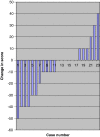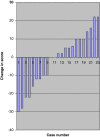Cauda equina syndrome treated by surgical decompression: the influence of timing on surgical outcome
- PMID: 17828560
- PMCID: PMC2140120
- DOI: 10.1007/s00586-007-0491-y
Cauda equina syndrome treated by surgical decompression: the influence of timing on surgical outcome
Abstract
A prospective longitudinal inception cohort study of 33 patients undergoing surgery for cauda equina syndrome (CES) due to a herniated lumbar disc. To determine what factors influence spine and urinary outcome measures at 3 months and 1 year in CES specifically with regard to the timing of onset of symptoms and the timing of surgical decompression. CES consists of signs and symptoms caused by compression of lumbar and sacral nerve roots. Controversy exists regarding the relative importance of timing of surgery as a prognostic factor influencing outcome. Post-operative outcome was assessed at 3 months and 1 year using the Oswestry Disability Index (ODI), Visual Analogue Scale (VAS) scores for leg and back pain and an incontinence questionnaire. Statistical analysis was used to determine the association between pre-operative variables and these post-operative outcomes with a specific emphasis on the timing of surgery. Surgery was performed on 12 (36%) patients within 48 h of the onset of symptoms including seven patients (21%) who underwent surgery within 24 h. Follow up was achieved in 27 (82%) and 25 (76%) patients at 3 and 12 months, respectively. There was no statistically significant difference in outcome between three groups of patients with respect to length of time from symptom onset to surgery- <24, 24-48 and >48 h. A significantly better outcome was found in patients who were continent of urine at presentation compared with those who were incontinent. The duration of symptoms prior to surgery does not appear to influence the outcome. This finding has significant implications for the medico-legal sequelae of this condition. The data suggests that the severity of bladder dysfunction at the time of surgery is the dominant factor in recovery of bladder function.
Figures






Comment in
-
Letter to the editor concerning "Cauda Equina Syndrome treated by surgical decompression: the influence of timing on surgical outcome" by A. Qureshi, P. Sell (2007) Eur Spine J 16:2143-2151.Eur Spine J. 2009 Sep;18(9):1391-2; author reply 1393. doi: 10.1007/s00586-009-1039-0. Epub 2009 Aug 8. Eur Spine J. 2009. PMID: 19669173 Free PMC article. No abstract available.
References
-
- {'text': '', 'ref_index': 1, 'ids': [{'type': 'DOI', 'value': '10.1097/00007632-200006150-00010', 'is_inner': False, 'url': 'https://doi.org/10.1097/00007632-200006150-00010'}, {'type': 'PubMed', 'value': '10851100', 'is_inner': True, 'url': 'https://pubmed.ncbi.nlm.nih.gov/10851100/'}]}
- Ahn UM, Ahn NU, Buchowski MS, Garrett ES, Sieber AN, Kostuik JP (2000) Cauda equina syndrome secondary to lumbar disc herniation. A meta-analysis of surgical outcomes. Spine 25:1515–1522 - PubMed
-
- {'text': '', 'ref_index': 1, 'ids': [{'type': 'PubMed', 'value': '8285904', 'is_inner': True, 'url': 'https://pubmed.ncbi.nlm.nih.gov/8285904/'}]}
- Dining TAR, Schaeffer HR (1993) Discogenic compression of the cauda equina: a surgical emergency. Aust NZ J Surg 63:927–934 - PubMed
-
- {'text': '', 'ref_index': 1, 'ids': [{'type': 'DOI', 'value': '10.1097/00007632-200011150-00017', 'is_inner': False, 'url': 'https://doi.org/10.1097/00007632-200011150-00017'}, {'type': 'PubMed', 'value': '11074683', 'is_inner': True, 'url': 'https://pubmed.ncbi.nlm.nih.gov/11074683/'}]}
- Fairbank JCT, Pynsent PB (2000) The oswestry disability index. Spine 25(22):2940–2953 - PubMed
-
- {'text': '', 'ref_index': 1, 'ids': [{'type': 'DOI', 'value': '10.3109/02688699008992725', 'is_inner': False, 'url': 'https://doi.org/10.3109/02688699008992725'}, {'type': 'PubMed', 'value': '2397046', 'is_inner': True, 'url': 'https://pubmed.ncbi.nlm.nih.gov/2397046/'}]}
- Gleave JRW, Macfarlane R (1990) Prognosis of recovery of bladder function following lumbar central disc prolapse. Br J Neurosurg 4:205–210 - PubMed
-
- {'text': '', 'ref_index': 1, 'ids': [{'type': 'DOI', 'value': '10.1080/0268869021000032887', 'is_inner': False, 'url': 'https://doi.org/10.1080/0268869021000032887'}, {'type': 'PubMed', 'value': '12389883', 'is_inner': True, 'url': 'https://pubmed.ncbi.nlm.nih.gov/12389883/'}]}
- Gleave JRW, Macfarlane R (2002) Cauda equina syndrome: what is the relationship between timing of surgery and outcome? Br J Neurosurg 16(4):325–328 - PubMed
MeSH terms
LinkOut - more resources
Full Text Sources

